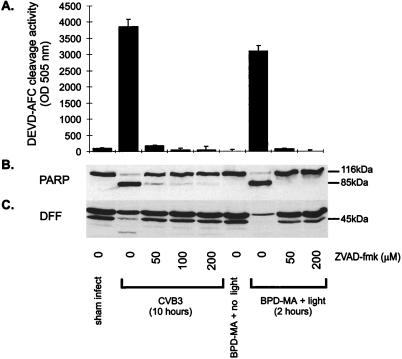FIG. 4.
ZVAD-fmk inhibits caspase activation as well as cleavage of PARP and DFF following CVB3 infection or induction of apoptosis by treatment of HeLa cells with BPD-MA and light. (A) Cell lysate was incubated in reaction buffer containing the caspase 3-specific substrate Ac-DEVD-AFC. After incubation at 37°C for 1 h, fluorescence levels were determined with an excitation wavelength of 400 nm and an emission wavelength of 505 nm. Note the lack of caspase activation in ZVAD-fmk (50 to 200 μM)-treated HeLa cells at 10 h following CVB3 infection and at 2 h following treatment with BPD-MA and light. (B) Cellular lysate was collected from treated HeLa cells, and immunoblot analysis was performed with an anti-PARP antibody. Note the equivalent cleavage of PARP in the CVB3-infected HeLa cells without ZVAD.fmk and the BPD-MA- and light-treated HeLa cells without ZVAD.fmk. ZVAD.fmk treatment (50 to 200 μM) of HeLa cells prevented PARP processing in the BPD-MA- and light-treated HeLa cells, while in CVB3-treated HeLa cells the PARP processing was limited, but not completely inhibited, by treatment with ZVAD.fmk at 50 or 100 μM. (C) Immunoblot analysis of DFF cleavage at 10 h following CVB3 infection and at 2 h following treatment with BPD-MA and light showed that the cleavage pattern was similar to that of PARP. Sham-infected cultures were treated the same as infected cultures, without virus.

